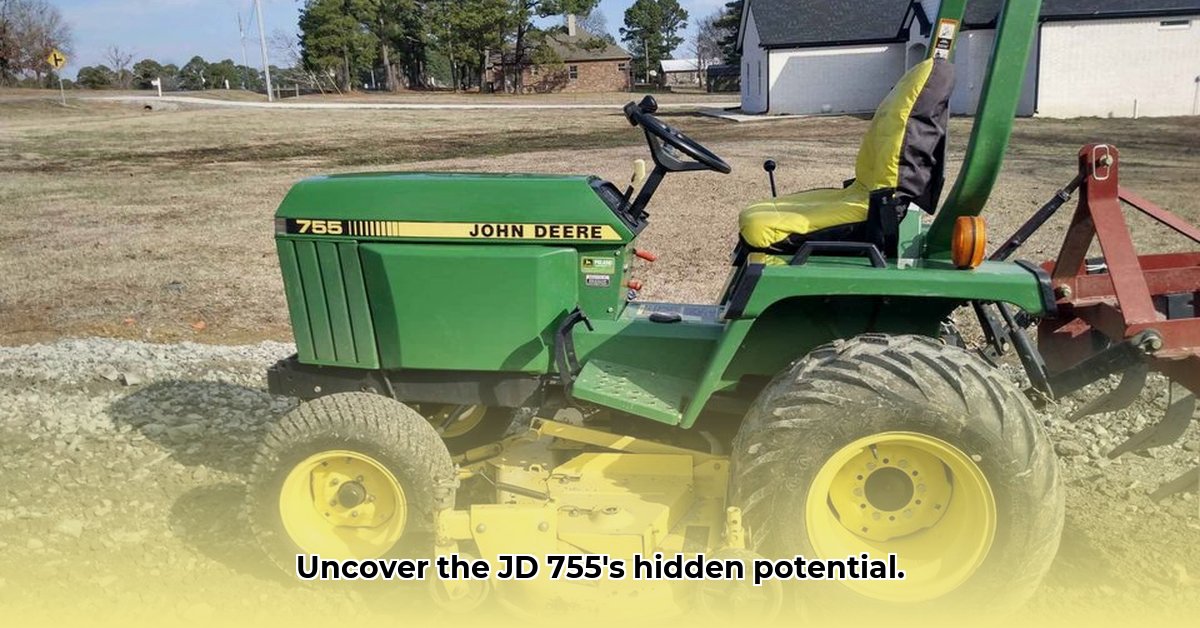
The John Deere 755, produced between 1986 and 1998, remains a popular compact utility tractor among enthusiasts and farmers alike. This guide explores its capabilities, maintenance needs, restoration process, and potential challenges for current owners. We’ll also address the often-tricky task of sourcing replacement parts. For authentic John Deere decals, check out this helpful resource.
Understanding the JD 755's Capabilities
The JD 755 boasts a 20-horsepower engine (a respectable output for its era), coupled with a 4.5-gallon hydraulic system. This combination makes it suitable for various tasks, including mowing, snowblowing, grading, and material handling using attachments like a front-end loader or backhoe. While lacking the advanced electronics of modern tractors, its straightforward mechanics offer a reliable workhorse for smaller operations. Isn't simplicity sometimes preferable to complexity, especially when dealing with machinery?
Preventative Maintenance: Keeping Your JD 755 Running Smoothly
Regular maintenance is paramount for extending the life of your JD 755. Here's a vital checklist:
Oil Changes: Always adhere to the owner's manual recommendations, using the specified oil type for optimal engine health. Neglecting oil changes significantly reduces engine lifespan.
Fluid Checks: Regularly monitor hydraulic fluid, coolant, and transmission fluid levels. Address any leaks promptly to prevent costly repairs. A small leak today could lead to substantial damage in the future.
Belt Inspections: Regularly inspect all belts for wear and tear. Promptly replace worn belts to avoid breakdowns. A sudden belt failure can cause significant inconvenience.
Tire Pressure: Maintaining correct tire pressure is crucial for performance and tire longevity. Underinflation leads to increased wear and tear, while overinflation can damage the tires.
Parts Sourcing: Locating replacement parts for older models requires persistence. Online marketplaces, salvage yards, and specialized suppliers are key resources. Networking with other JD 755 owners can also yield valuable leads.
Restoring Your JD 755: A Step-by-Step Guide
Restoring a JD 755 is a rewarding project, but it demands planning and patience. Follow these steps for a successful restoration:
Thorough Assessment: Begin with a detailed inspection, documenting each component's condition with photos and notes. This assessment informs your repair strategy.
Parts Acquisition: This phase often presents the greatest challenge. Utilize online marketplaces, salvage yards, and specialized suppliers. Consider the trade-offs between OEM (Original Equipment Manufacturer) and aftermarket parts.
Careful Disassembly: Disassemble the tractor methodically, cleaning and labeling every part for accurate reassembly. Organization is critical during this step.
Repair and Replacement: Repair or replace damaged components. Consult a qualified mechanic for complex repairs.
Meticulous Reassembly: Reassemble the tractor precisely, double-checking each connection.
Comprehensive Testing: Thoroughly test all systems after reassembly, making necessary adjustments.
The JD 755 Today: A Balanced Perspective
The JD 755, while lacking the advanced features of modern counterparts, remains a viable option for specific tasks and enthusiasts. Its robust build and simple mechanics are attractive to many. Its straightforward operation remains beneficial for smaller-scale projects.
However, for large-scale farming or heavy-duty applications, modern tractors offer superior efficiency and capabilities.
Potential Challenges: A Realistic Appraisal
Several obstacles accompany owning a JD 755:
Parts Availability: Sourcing original parts can be challenging and expensive.
Technological Limitations: Its simpler technology limits efficiency compared to modern models.
Maintenance Requirements: Regular maintenance is crucial to prevent major repairs.
Resale Value: The resale value depends heavily on the tractor's condition.
Finding Replacement Parts: A Practical Guide
Locating replacement parts requires a strategic approach.
Sourcing Parts: OEM vs. Aftermarket
OEM (Original Equipment Manufacturer) Parts: These offer superior quality but can be expensive and difficult to find. Direct contact with John Deere dealers may be necessary.
Aftermarket Parts: These offer greater availability and affordability, but quality can vary significantly. Thorough inspection is crucial before installation.
Where to Look for Parts
Online Marketplaces: Websites specializing in classic tractor parts are a valuable resource.
John Deere Dealers: While their online parts catalog may be inconsistent, contacting local dealers directly is recommended.
Online Auction Sites: These offer potential finds, but careful scrutiny of seller ratings and descriptions is required.
Online Tractor Communities: Engaging with online forums can lead to valuable part sources, repair tips, and networking opportunities.
Key Takeaway: A multi-pronged search strategy is advised when sourcing parts for a JD 755. Careful consideration of OEM vs. aftermarket options, coupled with thorough research, maximizes the chances of success. Remember, patience is paramount in this process.